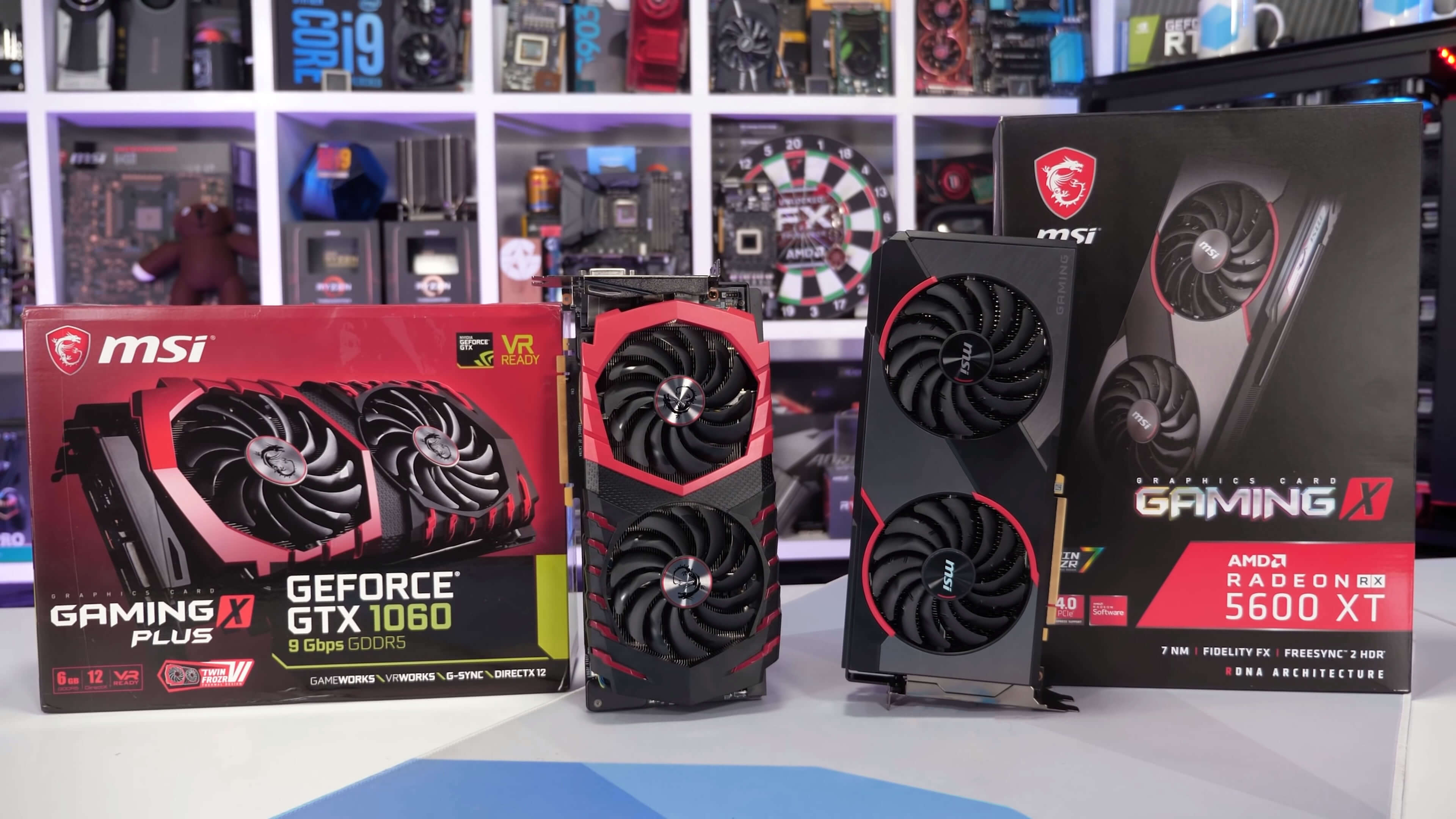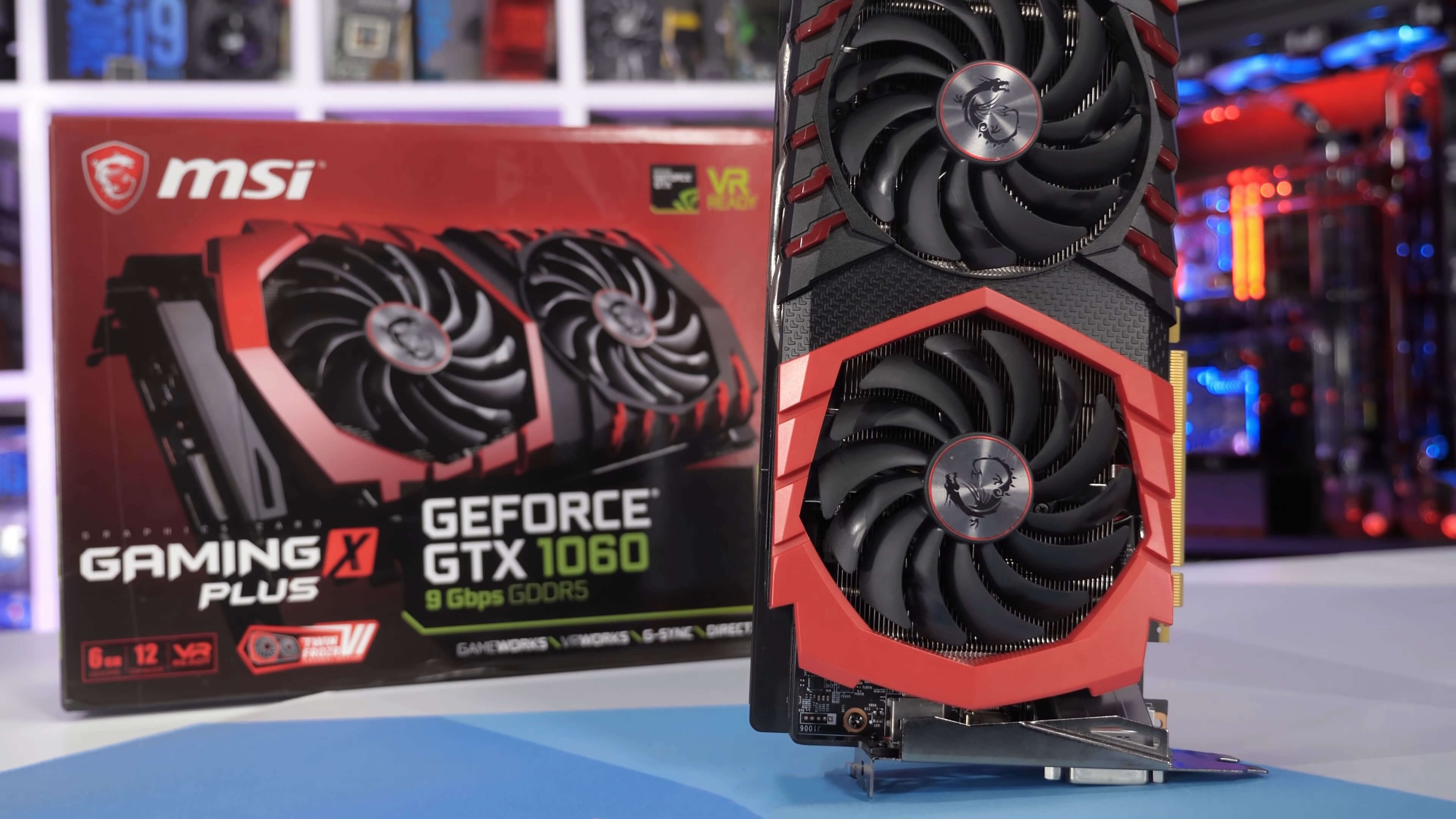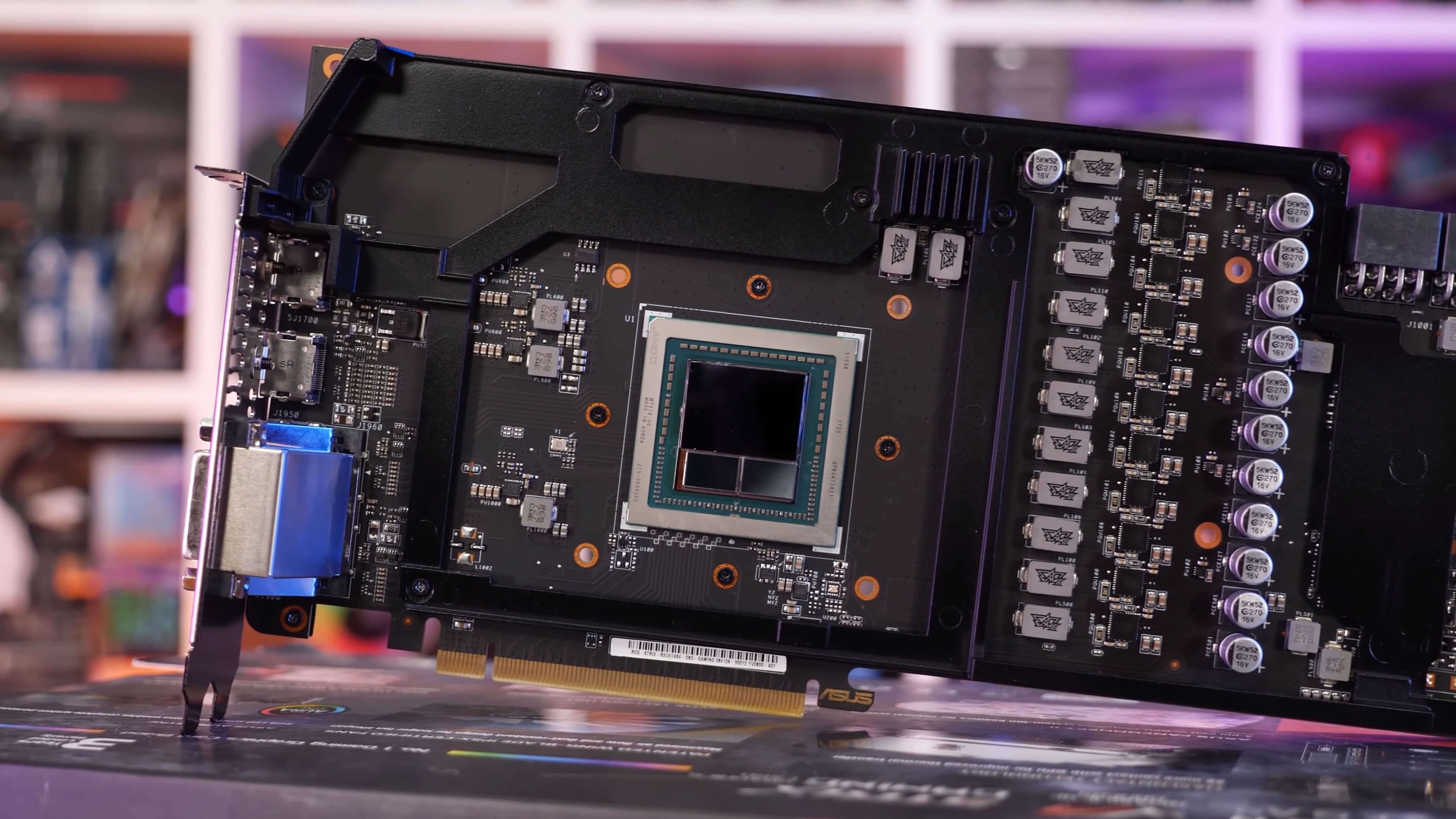[ad_1]
Today we’re running the Radeon RX 5600 XT through more than 30 games for the first time and for comparison we have the older Pascal-based GTX 1070 and 1060 GPUs. We’ve also thrown in the RTX 2060 Super and RX 5700 XT for good measure considering we already had most of that data.
The key takeaway for this article is to see what kind of upgrade the Radeon 5600 XT offers over the GTX 1060 when testing a huge range of games. This will also give RX 580 owners a good idea how much faster the 5600 XT is as we found last year when testing 38 titles that the 580 was only 2-3% faster than the 1060 on average. That’s another GPU battle we’ll probably revisit shortly.
The GeForce GTX 1060 6GB was introduced for $250 back in July 2016, about three and a half years ago. The version used for testing in this video is technically $300, as it packs updated 9 Gbps GDDR5 memory, but with very minor performance gains of 3-4% on offer, there wasn’t much in it, so the results here will be representative of the more premium GTX 1060 models, which were priced around $280 upon release.
Recently we found that for about the same price at launch, the 5700 XT was ~50% faster than the GTX 1070, so we’re interested to see if the 5600 XT can offer similar gains over the GTX 1060. As we just mentioned, it’s been nearly four years, so we’re hoping for at least a 50% performance improvement.
Representing the GTX 1060 and GTX 1070 we have MSI’s Gaming X Plus models, both will be going head to head with MSI’s RX 5600 XT Gaming X. Powering our GPU test rig is an Intel Core i9-9900K overclocked to 5 GHz with 16GB of DDR4-3400 memory. As usual, rather than go over all 32 graphs, we’ll look at around a dozen closely and then jump into the performance breakdown graphs.
Benchmarks
First up we have Assassin’s Creed Odyssey where the 5600 XT is only able to match the GTX 1070. This isn’t a terrible result considering the GeForce GPU cost at least $100 more upon release, but that was over three years ago.
Matching the 1070 meant that the 5600 XT was 26% faster than the 1060 at 1080p and 31% faster at 1440p. Not exactly impressive gains, so hopefully these numbers grow in other titles.


Again we can see that the 5600 XT is only able to match the GTX 1070, this time when testing with Star Wars Jedi Fallen Order. The Radeon was 31% faster than the GTX 1060 at 1080p, though that margin did grow to 43% at 1440p, so at least in this title the 5600 XT is significantly more capable at this higher resolution.

The Outer Worlds uses the Unreal Engine and since this engine has been better optimized for Nvidia hardware, the 5600 XT doesn’t fair all that well against the GTX 1070, falling short by around 7-8% at both tested resolutions. That makes the new Radeon GPU a pretty weak upgrade for GTX 1060 owners in this title, just a 21% gain at 1080p and 25% at 1440p.

We get our first example of the 5600 XT easily outperforming the GTX 1070 in Call of Duty. Here it was 15% faster at 1080p and 16% faster at 1440p. The Radeon was almost 50% faster than the GTX 1060 at 1080p and 55% faster at 1440p. That’s the kind of solid performance uplift that would warrant the upgrade.

The Red Dead Redemption 2 benchmark results are interesting and we see the first bit of real trouble for the 6GB 5600 XT. The frame time performance at 1080p wasn’t great, we see a very large disparity between the 1% low and average frame rate, a similar problem is also seen with the GTX 1060, another 6GB model.
The problem is amplified at 1440p where the 5600 XT sees 1% lows drop to 22 fps, around 3x lower than that of the Radeon 5700 XT. The 5600 XT was also just 28% faster than the GTX 1060, though never delivered satisfactory performance at 1440p.

The Radeon 5600 XT was 20% faster than the GTX 1070 in Control at 1080p, though both delivered similar 1% low performance. Still that meant the Navi based GPU was between 41 and 65% faster than the GTX 1060, so a rather significant performance uplift there. The gains were very similar at both 1080p and 1440p.

The 5600 XT performed well when testing with World War Z, here it was 19% faster than the GTX 1070 at 1080p and that meant it was 60% faster than the GTX 1060.
Do note the old $250 Pascal GPU had no trouble delivering playable performance at 1080p. It did struggle a little at 1440p, though 56 fps on average with 48 fps for the 1% low is still very playable. But for up to 70% more performance, the 5600 XT is a nice upgrade.

F1 2019 is another title where the Radeon 5600 XT performed really well. Here it outpaced the GTX 1070 by a 20% margin at 1080p. This allowed the Radeon GPU to deliver almost 70% more frames than the GTX 1060, so a massive upgrade for F1 fans. Margins were much the same at 1440p.

For testing with Tom Clancy’s Rainbow Six Siege we’ve updated to the Vulkan API. Here the 5600 XT was 10% faster than the GTX 1070 and that meant it was 55% faster than the GTX 1060.
The same 55% performance gain was seen at 1440p and here it’s much more significant as it took us from 56 fps on average to 87 fps.

Testing with Fortnite, the 5600 XT was able to outpace the GTX 1070 again though only by a 6% margin. By beating the GTX 1070, it also means it was a good bit faster than the 1060, boosting frame rates by 51% at 1080p.
The boost from 50 fps on average to 77 fps at 1440p will be the most noticeable, we’re looking at a whopping 54% performance increase at the larger resolution.

The performance margins in Gears 5 are similar to the past few games we’ve looked at. The 5600 XT edged ahead of the GTX 1070 to beat the 1060 by a convincing 48% margin at 1080p and 49% at 1440p.

Typically Radeon GPUs perform well in Shadow of the Tomb Raider and the 5600 XT is no exception. Here it was 55% faster than the GTX 1060 at 1080p and 53% faster at 1440p. Solid gains across the board.

Our Apex Legends Season 4 testing shows the 5600 XT matching the GTX 1070 at 1080p, but beating it by a 14% margin at 1440p which is interesting. The GTX 1060 also performs surprisingly well, at 1080p the 5600 XT was just 28% faster, though that margin was extended out to 44% at 1440p.

The last set of results we’re going to discuss in detail are from Borderlands 3. We see very strong performance from the 5600 XT: at 1080p it crushed the GTX 1060 by a 62% margin and then almost by 70% at 1440p.
Performance Summary
Compared to the older Pascal-based GPUs, the Radeon 5600 XT looks like it could be a viable upgrade for GTX 1060 owners, though probably not for those looking for a solid upgrade from the GTX 1070.
Above we took a look and discussed the results of 14 out of the 32 games we tested. Here’s a look at the average performance across all the titles and then a head to head comparison between the 5600 XT and GTX 1060.

On average, the Radeon 5600 XT is 8% faster than the GTX 1070 at 1080p. That’s not a viable upgrade for owners of the ~$400 Pascal GPU from a few years ago. However when compared to the GTX 1060 we’re looking at a 47% performance increase, and that’s pretty substantial.
Also, when compared to the $250 base model GTX 1060’s you’d be looking at just over a 50% performance increase on average. The margins are basically identical at 1440p as well. It is important to see what are the games driving the most substantial gains though…
Radeon RX 5600 XT vs. GeForce GTX 1060 in 32 games at 1080p

When we look at the results on a per game basis we can see that while the 5600 XT is ~50% faster on average, the results can vary significantly from game to game. The Ghost Recon Breakpoint results are a massive outlier, so we went back and retested that title. For whatever reason the 5600 XT just doesn’t perform very well in that game. You’d think this is a driver issue, but the 5700 XT easily beats the RTX 2060 Super, so perhaps this is memory limitation at work.
There are 8 titles where the Radeon 5600 XT was faster by a 60% margin or greater with another 8 titles where it was only faster by a 31% margin or less, excluding the Breakpoint outlier. If you predominantly play PUBG, for example, the upgrade from the GTX 1060 to the 5600 XT won’t be worth it, you’d be better off looking at the RTX 2060 in this instance.
Radeon RX 5600 XT vs. GeForce GTX 1060 in 32 games at 1440p

The margins are very similar at 1440p, though overall the 5600 XT does fair a little better in its battle with the GTX 1060.
What We Learned
With such an extensive number of games tested, we can easily conclude the Radeon RX 5600 XT is ~50% faster than the GTX 1060 and that makes it a solid upgrade choice for most gamers. The caveat to the rule will come depending on the games you play the most, which you can see for yourself using the graphs above.
The GeForce GTX 1060 base models were available at $250 at launch with models such as the MSI Gaming X+ priced around $300. Realistically, you could achieve a similar level of performance for around $270-$280, or a similar price to today’s base model 5600 XTs. If you were to say a quality GTX 1060 would have set you back around $270 three years ago, that would make the 5600 XT ~7-10% more expensive. Or if we compared MSRPs of $250 vs. $280, the 5600 XT comes out 12% more expensive, so let’s go with that as a worst case scenario.
After about 3.5 years you’re looking at about a 50% performance increase for a 12% increase in price, not amazing, but not terrible either given the lack of competition during that time.
The problem the Radeon 5600 XT faces when it comes to the value equation is the same problem every sub-$300 GPU has had over the past year or so: heavily discounted RX 580 cards are still available. Upon the 5600 XT’s release a month ago you could buy an 8GB 580 for $180, and now they’re down to $170 with some models bottoming out at just $160. If we assume the RX 580 and GTX 1060 are still neck and neck, that would mean although the 5600 XT is about 50% faster than the 580, it also costs at least 55% more.
But if we focus on raw performance, the Radeon 5600 XT is impressive in terms of value given it’s a few tiers above the RX 580. We’re probably looking more at Vega 56-type performance, as Vega 56 was ~10% faster than the GTX 1070 when we last tested it.
The Radeon Vega 56 came in at $400 (sort of), which makes the 5600 XT a good bit cheaper and it also uses way less power. This is a good step forward for AMD in a two year timeframe. The hope is that AMD can continue to become more competitive across the board and this will help drive GPU prices down.
We saw years of stagnation on the CPU front when AMD had nothing and Intel reigned free. We’re looking at a similar outcome for GPUs over the past few years. Hopefully Radeon can have a Ryzen moment in the not too distant future.
Shopping Shortcuts:
- AMD Radeon RX 5600 XT on Amazon
- GeForce RTX 2060 on Amazon
- GeForce RTX 2060 Super on Amazon
- AMD Radeon RX 5700 on Amazon
- AMD Radeon RX 5700 XT on Amazon
- GeForce GTX 1660 Super on Amazon
- GeForce RTX 2070 Super on Amazon
- GeForce RTX 2080 Ti on Amazon
- AMD Ryzen 9 3900X on Amazon
- AMD Ryzen 5 3600 on Amazon
[ad_2]
Source link






